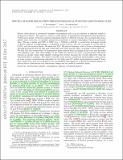Files in this item
Spectra of Earth-like planets through geological evolution around FGKM stars
Item metadata
| dc.contributor.author | Rugheimer, Sarah | |
| dc.contributor.author | Kaltenegger, Lisa | |
| dc.date.accessioned | 2018-01-04T14:30:06Z | |
| dc.date.available | 2018-01-04T14:30:06Z | |
| dc.date.issued | 2018-02-07 | |
| dc.identifier | 251868830 | |
| dc.identifier | 9daa5977-1580-461c-a04b-20747d3dd9cc | |
| dc.identifier | 85042434594 | |
| dc.identifier | 000424502900007 | |
| dc.identifier.citation | Rugheimer , S & Kaltenegger , L 2018 , ' Spectra of Earth-like planets through geological evolution around FGKM stars ' , Astrophysical Journal , vol. 854 , 19 . https://doi.org/10.3847/1538-4357/aaa47a | en |
| dc.identifier.issn | 0004-637X | |
| dc.identifier.other | ArXiv: http://arxiv.org/abs/1712.10027v1 | |
| dc.identifier.other | ORCID: /0000-0003-1620-7658/work/41547360 | |
| dc.identifier.uri | https://hdl.handle.net/10023/12429 | |
| dc.description | This work was supported by a grant from the Simons Foundation (SCOL awards 339489 to SR and 290357 to LK). | en |
| dc.description.abstract | Future observations of terrestrial exoplanet atmospheres will occur for planets at different stages of geological evolution. We expect to observe a wide variety of atmospheres and planets with alternative evolutionary paths, with some planets resembling Earth at different epochs. For an Earth-like atmospheric time trajectory, we simulate planets from prebiotic to current atmosphere based on geological data. We use a stellar grid F0V to M8V (Teff = 7000 K to 2400 K) to model four geological epochs of Earth's history corresponding to a prebiotic world (3.9 Ga), the rise of oxygen at 2.0 Ga and at 0.8 Ga, and the modern Earth. We show the VIS - IR spectral features, with a focus on biosignatures through geological time for this grid of Sun-like host stars and the effect of clouds on their spectra. We find that the observability of biosignature gases reduces with increasing cloud cover and increases with planetary age. The observability of the visible O2 feature for lower concentrations will partly depend on clouds, which while slightly reducing the feature increase the overall reflectivity thus the detectable flux of a planet. The depth of the IR ozone feature contributes substantially to the opacity at lower oxygen concentrations especially for the high near-UV stellar environments around F stars. Our results are a grid of model spectra for atmospheres representative of Earth's geological history to inform future observations and instrument design and are publicly available online at http://carlsaganinstitute.org/data/. | |
| dc.format.extent | 6437153 | |
| dc.language.iso | eng | |
| dc.relation.ispartof | Astrophysical Journal | en |
| dc.subject | Astrobiology | en |
| dc.subject | Planets: atmospheres | en |
| dc.subject | Planets: terrestrial planets | en |
| dc.subject | QB Astronomy | en |
| dc.subject | GE Environmental Sciences | en |
| dc.subject | QE Geology | en |
| dc.subject | NDAS | en |
| dc.subject.lcc | QB | en |
| dc.subject.lcc | GE | en |
| dc.subject.lcc | QE | en |
| dc.title | Spectra of Earth-like planets through geological evolution around FGKM stars | en |
| dc.type | Journal article | en |
| dc.contributor.institution | University of St Andrews. School of Earth & Environmental Sciences | en |
| dc.contributor.institution | University of St Andrews. St Andrews Centre for Exoplanet Science | en |
| dc.identifier.doi | 10.3847/1538-4357/aaa47a | |
| dc.description.status | Peer reviewed | en |
| dc.identifier.url | https://arxiv.org/abs/1712.10027v1 | en |
| dc.identifier.url | http://iopscience.iop.org/article/10.3847/1538-4357/aaa47a | en |
This item appears in the following Collection(s)
Items in the St Andrews Research Repository are protected by copyright, with all rights reserved, unless otherwise indicated.

